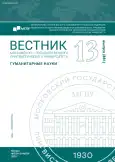Interpreting Socio-Ritual Texts. Some Features
- Авторлар: Firstov M.S.1
-
Мекемелер:
- Moscow State Linguistic University
- Шығарылым: № 13(881) (2023)
- Беттер: 102-108
- Бөлім: Linguistics
- URL: https://journal-vniispk.ru/2542-2197/article/view/322393
- ID: 322393
Дәйексөз келтіру
Толық мәтін
Аннотация
The author of the article uses the material of the German language to review features typical of a group of genres in oral monologic public speech - socio-ritual texts. They include lack of new information for the listener, imagery, predominance of form over content, use of stylistic figures and ritualistic repetitions. The author demonstrates how specific features of socio-ritual texts influence an interpreter who is getting prepared to work with such texts.
Негізгі сөздер
Авторлар туралы
Mikhail Firstov
Moscow State Linguistic University
Хат алмасуға жауапты Автор.
Email: mfirstov@mail.ru
Senior lecturer at the Department of German and Translation and Interpreting Faculty of Translation and Interpreting Moscow State Linguistic University
РесейӘдебиет тізімі
- Agranovich, S. Z., Berezin S. V. (2005). Homo amphibolos: Arheologiya soznaniya = Homo amphibolos: Archaeology of consciousness. Samara: BAHRAH-M. (In Russ.)
- Zhuravlev, I. V. (2017). Soznanie i mif: Chto my delaem, chtoby byt’ soznatel’nymi sushchestvami = Consciousness and Myth: What we do to be conscious beings. Moscow: Knizhnyj dom “Librokom”. (In Russ.)
- Mechkovskaya, N. B. (1998). Yazyk i religiya. Lekcii po filologii i istorii religij = Language and Religion. Lectures on philology and history of religions: Manual for students of humanitarian universities. Moscow: FAIR. (In Russ.)
- Firstov, M. S. (2011). Pre-interpreting analysis in interpreter training. Vestnik of Moscow State Linguistic University, 20 (626), 75–85. (In Russ.)
- Lasswell, H. D. (2003). The structure and function of communication in society. In: Nazarov M. M. Massovaya kommunikaciya i obshchestvo. Vvedenie v teoriyu i issledovaniya = Mass Communication and Society. Introduction to theory and research. Moscow: Avanti plyus, 233–242. (In Russ.)
- Zwilling, M. Ya. (2007). Ponyatie perevodcheskoj konstellyacii = Concept of translation constellation. Tetradi perevodchika: nauchno-teoreticheskij sbornik, 26. Moscow: Rema, 63–72. (In Russ.)
- Gofman, V. A. (1932). Slovo oratora: Ritorika i politika = Speaker’s word: Rhetoric and politics, Leningrad: Izdatel’stvo pisatelej v Leningrade. (In Russ.)
- Karabykov, A. V. (2012). Meaning and fate of rhetoric in the Christian medieval culture. Vestnik of Tomsk State University. Philology, 1(17), 23–33
- Ivanov, V. V. (2009). Izbrannye trudy po semiotike i istorii kul’tury. T. 5: Mifologiya i fol’klor = Selected works on semiotics and history of culture. Volume 5: Mythology and Folklore. Moscow: Znak. (In Russ.)
- Leont’ev, A. A. (1999). Psihologiya obshcheniya = Psychology of communication. Moscow: Smysl. (In Russ.)
- Solganik, G. Ya. (2010). Osnovy lingvistiki rechi = Speech linguistics basics. Moscow: Moscow State University. (In Russ.)
- Brandes, M. P. (1990). Stilistik der deutschen Sprache. Moscow: Vysshaya shkola. (In Russ.)
- Durkheim, E. (2018). The Elementary Forms of Religious Life. Moscow: Delo. (In Russ.)
- Leont’ev, A. A. (2008). Prikladnaya psiholingvistika rechevogo obshcheniya i massovoj kommunikacii = Applied psycholinguistics of verbal communication and mass communication. Moscow: Smysl. (In Russ.)
Қосымша файлдар










